Beer and salt among Roman 'mega-industries'
Katy Prickett
BBC News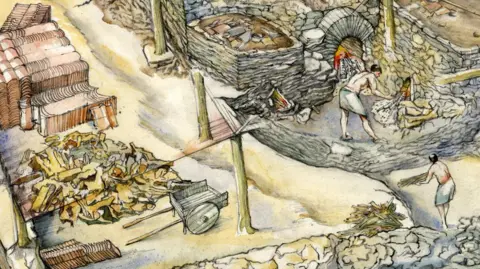
Mark Gridley/Oxford Archaeology
A huge amount of tiles were made at a villa estate near Corby, including an "exceptional find" of a tile kiln (artist's impression)
Imagining Roman Britain conjures up images of emperors, gladiators, posh villas - and the army that held the empire together.
But a much more varied story is emerging, thanks to evidence uncovered by excavations in recent years.
Beer brewing was just one of the industries that grew rapidly to supply the military, and small towns and cities like Camulodunum (Colchester) and Verulamium (St Albans) in the three-and-a-half centuries of Roman rule.
So, what have these digs revealed about daily life in Roman Britain
From invasion to industrialisation
A huge amount of tiles were made at a villa estate near Corby, including an "exceptional find" of a tile kiln (artist's impression)
Imagining Roman Britain conjures up images of emperors, gladiators, posh villas - and the army that held the empire together.
But a much more varied story is emerging, thanks to evidence uncovered by excavations in recent years.
Beer brewing was just one of the industries that grew rapidly to supply the military, and small towns and cities like Camulodunum (Colchester) and Verulamium (St Albans) in the three-and-a-half centuries of Roman rule.
So, what have these digs revealed about daily life in Roman Britain
From invasion to industrialisation

Getty Images
The need to supply the army was a "key driver" of the growth of industries across Roman Britain
It took the Romans about 45 years to take over most of England and Wales after they invaded in AD 43, arriving in a disunited land dominated by tribal leaders.
The need to supply their army was the "key driver", according to archaeologist Edward Biddulph, as well as the urban centres they created. This led to the rapid industrial development.
The Oxford Archaeology senior project manager said pottery, building materials, metalwork and glass were all being produced across the country, but from the 3rd and 4th Centuries "we start to see mega industries".
"We know industrial activity was undertaken at a very large scale at a number of sites in Roman Britain and we have some very large sites that are helping us to really fill in the gaps in our knowledge, the missing pieces that we've long been struggling with," he said.
"One of the classic areas is malting and brewing, if you look at Roman Britain you see next to nothing about this, yet people must have been drinking beer."
Romano-Britons made a lot of beer
The need to supply the army was a "key driver" of the growth of industries across Roman Britain
It took the Romans about 45 years to take over most of England and Wales after they invaded in AD 43, arriving in a disunited land dominated by tribal leaders.
The need to supply their army was the "key driver", according to archaeologist Edward Biddulph, as well as the urban centres they created. This led to the rapid industrial development.
The Oxford Archaeology senior project manager said pottery, building materials, metalwork and glass were all being produced across the country, but from the 3rd and 4th Centuries "we start to see mega industries".
"We know industrial activity was undertaken at a very large scale at a number of sites in Roman Britain and we have some very large sites that are helping us to really fill in the gaps in our knowledge, the missing pieces that we've long been struggling with," he said.
"One of the classic areas is malting and brewing, if you look at Roman Britain you see next to nothing about this, yet people must have been drinking beer."
Romano-Britons made a lot of beer
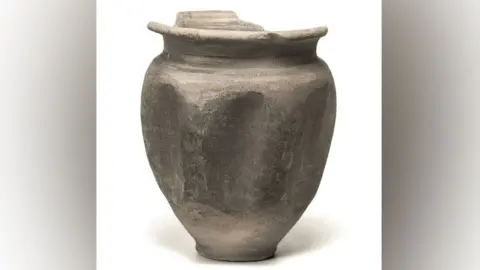
Oxford Archaeology
Large beer beakers like this one were discovered at Berryfields, alongside stone-line wells, timber-lined tanks, tile-lined drains, a malting oven and enormous quantities of germinated grain
Evidence of brewing on an industrial level was discovered at a Roman villa at North Fleet in Kent, and using the features found there - such as malting ovens and lined tanks for steeping the grain - archaeologists knew what to look for at smaller sites.
One of those was Berryfields, a development near Aylesbury, Buckinghamshire, excavated between 2007 and 2016.
"Oven-like structures" often found at Roman settlements had previously been believed to be used for drying corn.
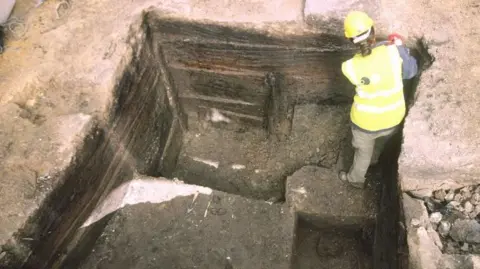
Large beer beakers like this one were discovered at Berryfields, alongside stone-line wells, timber-lined tanks, tile-lined drains, a malting oven and enormous quantities of germinated grain
Evidence of brewing on an industrial level was discovered at a Roman villa at North Fleet in Kent, and using the features found there - such as malting ovens and lined tanks for steeping the grain - archaeologists knew what to look for at smaller sites.
One of those was Berryfields, a development near Aylesbury, Buckinghamshire, excavated between 2007 and 2016.
"Oven-like structures" often found at Roman settlements had previously been believed to be used for drying corn.

Oxford Archaeology
Industrial-levels of beer brewing were uncovered by archaeologists in Kent, including a malting tank (above), which helps them recognise similar but smaller brewing features at other sites
Mr Biddulph said now they are "recognised as malting ovens, used to heat partially germinated grain to produce malt".
"At Berryfields, we found evidence of malting and brewing and the tanks used to steep the grain before processing," he said.
"We tend to think of the Roman world as being very much a wine-loving place.
"But actually a lot of the population in Roman Britain were drinking beer and we see that in the pottery they were using, large beakers in the same sort of sizes as modern pint glasses."
Sea salt and fish sauce

Essex is famous for its Maldon Sea Salt company, but the Romans first extracted the condiment on industrial levels in the county
Another industry that began producing on an industrial scale was discovered at Stanford Wharf Nature Reserve, near Thurrock in Essex, in 2009.
The excavation revealed salt had been extracted there from the Iron Age, but that really ramped up in the 3rd and 4th centuries.
Mr Biddulph said: "Salt was one of the most important commodities in the Roman world, not only used for flavour and to preserve food but in religious activity and for cleansing.
"In fact the Roman author Pliny the Elder said 'Civilised life can't proceed without salt'."
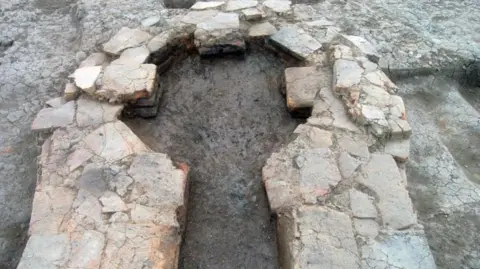
Industrial-levels of beer brewing were uncovered by archaeologists in Kent, including a malting tank (above), which helps them recognise similar but smaller brewing features at other sites
Mr Biddulph said now they are "recognised as malting ovens, used to heat partially germinated grain to produce malt".
"At Berryfields, we found evidence of malting and brewing and the tanks used to steep the grain before processing," he said.
"We tend to think of the Roman world as being very much a wine-loving place.
"But actually a lot of the population in Roman Britain were drinking beer and we see that in the pottery they were using, large beakers in the same sort of sizes as modern pint glasses."
Sea salt and fish sauce

Essex is famous for its Maldon Sea Salt company, but the Romans first extracted the condiment on industrial levels in the county
Another industry that began producing on an industrial scale was discovered at Stanford Wharf Nature Reserve, near Thurrock in Essex, in 2009.
The excavation revealed salt had been extracted there from the Iron Age, but that really ramped up in the 3rd and 4th centuries.
Mr Biddulph said: "Salt was one of the most important commodities in the Roman world, not only used for flavour and to preserve food but in religious activity and for cleansing.
"In fact the Roman author Pliny the Elder said 'Civilised life can't proceed without salt'."

Oxford Archaeology
They used tile-hearths to evaporate the salt as the industry ramped up from the late 3rd Century onwards, used for flavour, preservation and in religious rituals
With its location on the Thames estuary, the salt was probably exported to London, but also across the rest of the country and abroad. The county still hosts the industry, as the home of Maldon Sea Salt.
"And actually, more excitingly there was evidence that they made a fermented fish sauce, and fish sauce was like the Roman tomato sauce, that they used on absolutely everything," Mr Biddulph said.
For centuries, the sauce had been imported from Spain, but after that industry collapsed it looks like the Essex manufacturer stepped into the gap.
Villa estates as industrial hubs
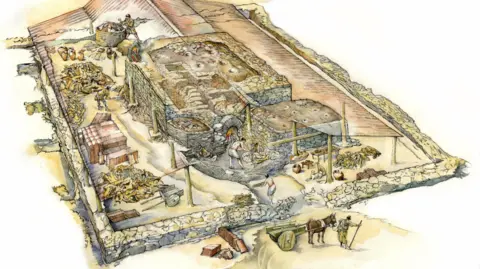
They used tile-hearths to evaporate the salt as the industry ramped up from the late 3rd Century onwards, used for flavour, preservation and in religious rituals
With its location on the Thames estuary, the salt was probably exported to London, but also across the rest of the country and abroad. The county still hosts the industry, as the home of Maldon Sea Salt.
"And actually, more excitingly there was evidence that they made a fermented fish sauce, and fish sauce was like the Roman tomato sauce, that they used on absolutely everything," Mr Biddulph said.
For centuries, the sauce had been imported from Spain, but after that industry collapsed it looks like the Essex manufacturer stepped into the gap.
Villa estates as industrial hubs

Mark Gridley/Oxford Archaeology
Archaeologists already knew two Roman villas had been discovered at this site near Corby, but in 2020 they unearthed evidence of late 3rd to early 4th Century industry
The 3rd Century onwards saw the establishment of large "villa estates", said Mr Biddulph.
The driver for that seems to have been the need to feed the Roman army, especially the soldiers stationed along the River Rhine in present-day Germany.
These estates also had their industrial areas, as an excavation near Corby, Northamptonshire, revealed in 2020.
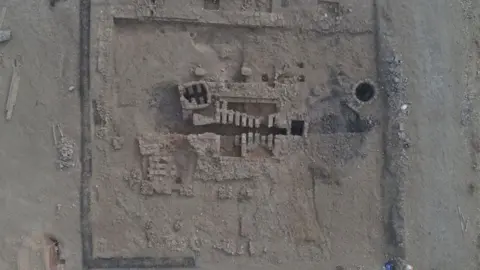
The 3rd Century onwards saw the establishment of large "villa estates", said Mr Biddulph.
The driver for that seems to have been the need to feed the Roman army, especially the soldiers stationed along the River Rhine in present-day Germany.
These estates also had their industrial areas, as an excavation near Corby, Northamptonshire, revealed in 2020.

Oxford Archaeology
An aerial shot of the kiln, set within a Roman mausoleum, reveals how much of the structures had survived the centuries
Evidence of pottery, ceramic building material such as roof tiles and bricks and lime, were unearthed but "a tile kiln was an exceptional discovery".
He said: "One of the features was a nice, really well-made engineered army-built road.
"There was no Roman fort there, but it just shows how connected these villa owners were to the elite and having their own army-built road really shows this.
And in a glimpse of its long-dead inhabitants, the imprint of a woman's sandal and animal footprints were found on some of the tile rejects, while another tile had a finger-made inscription.
Major pottery production centre

An aerial shot of the kiln, set within a Roman mausoleum, reveals how much of the structures had survived the centuries
Evidence of pottery, ceramic building material such as roof tiles and bricks and lime, were unearthed but "a tile kiln was an exceptional discovery".
He said: "One of the features was a nice, really well-made engineered army-built road.
"There was no Roman fort there, but it just shows how connected these villa owners were to the elite and having their own army-built road really shows this.
And in a glimpse of its long-dead inhabitants, the imprint of a woman's sandal and animal footprints were found on some of the tile rejects, while another tile had a finger-made inscription.
Major pottery production centre

Oxford Archaeology
Very large jars were being produced at a pottery at Horningsea,
Goods like olive oil and wine were imported to Britain using large ceramic jars known as amphora, but Romano-Britons "produced their own big jars which could rival this pottery", said Mr Biddulph.
A 2021 excavation at Horningsea, next to the River Cam in Cambridgeshire, revealed it was a major pottery production area.
Mr Biddulph said: "Its most distinctive aspect was the production of very large jars.
"These may have been a specialist line, but it is unclear whether they were associated with a specific commodity, as transport containers, perhaps for flour, or whether they were simply a particularly successful form of all-purpose storage jar."
What he does believe is the pottery was producing the jars were most likely to have been used in the vicinity, unlike the imported amphora.
And what about the people who toiled in these industries?
"It's a tricky question because we don't have the evidence, but it was probably not just the enslaved, but a range of people," said Mr Biddulph.
"And it was a pretty tough life, not particularly pleasant, where ever you were on the social scale."
Very large jars were being produced at a pottery at Horningsea,
Goods like olive oil and wine were imported to Britain using large ceramic jars known as amphora, but Romano-Britons "produced their own big jars which could rival this pottery", said Mr Biddulph.
A 2021 excavation at Horningsea, next to the River Cam in Cambridgeshire, revealed it was a major pottery production area.
Mr Biddulph said: "Its most distinctive aspect was the production of very large jars.
"These may have been a specialist line, but it is unclear whether they were associated with a specific commodity, as transport containers, perhaps for flour, or whether they were simply a particularly successful form of all-purpose storage jar."
What he does believe is the pottery was producing the jars were most likely to have been used in the vicinity, unlike the imported amphora.
And what about the people who toiled in these industries?
"It's a tricky question because we don't have the evidence, but it was probably not just the enslaved, but a range of people," said Mr Biddulph.
"And it was a pretty tough life, not particularly pleasant, where ever you were on the social scale."
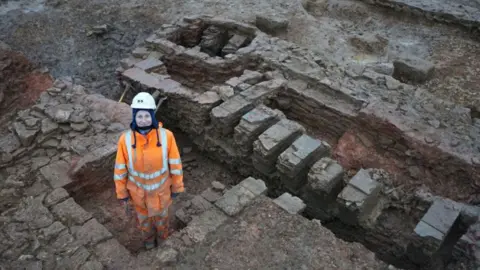
Oxford Archaeology
While the 3rd to 4th Centuries were the golden age of the Roman villa in Britain, they were typically at the heart of busy industrial sites
While the 3rd to 4th Centuries were the golden age of the Roman villa in Britain, they were typically at the heart of busy industrial sites
A Greek mosaic, an Etruscan temple and lead ingots: Extraordinary discoveries in Europe this week
Rebecca Ann HughesSat, 10 August 2024
It’s been a bumper week for archaeological discoveries in Europe, with a Greek mosaic and an Etruscan temple being unearthed and new research released on ingots found in Spain.
Each finding has shed light on different aspects of ancient civilisations and their culture. Here’s why they are significant.
Archaeologists discover 2700-year-old Etruscan temple in Tuscany
Archaeologists in the Italian region of Tuscany have unearthed a 2700-year-old Etruscan temple at the Sasso Pinzuto necropolis.
The cult building is one of the largest of its kind measuring 6.2 by 7.1 metres.
The excavation was carried out by the Centre for Ancient Mediterranean and Near Eastern Studies (CAMNES) in collaboration with the University of Naples Federico II.
The team found tuffaceous opus quadratum foundations (an ancient Roman construction technique using squared blocks of stone) of a rectangular structure, known as an oikos meaning house of the deity.
The discovery will shed light on funerary cults in Tuscania during the Archaic period. Nearby, burial mounds and trenches for cult activities were also found.
"In all likelihood, the Sasso Pinzuto oikos will become a reference for funerary cults in Archaic Etruscan necropolis," said Professor Alessandro Naso of the University of Naples.
The Sasso Pinzuto site has been under excavation since the mid-19th century and is home to over 120 chamber tombs dating from as early as the 7th century BC.
Ancient Greek mosaic of naked satyrs discovered on Evia
On the Greek island of Evia, archaeologists have uncovered a mosaic floor which was stumbled upon during works to install water pipelines.
The modern town of Eretria is home to the remains of an ancient Greek city dating from the middle of the first millennium BC.
The remarkable artwork depicts two naked satyrs. The figures are half human, half animal, with goat or horse-like features including tails, pointed ears and horns.

The mosaic was discovered inside a house from the 4th century BC which would have stood in the heart of the ancient city and was likely owned by a wealthy family. - Greek Ministry of Culture
In Greek mythology, satyrs were human-animal hybrid spirits closely connected to the cult of Dionysus, the god of fertility, wine, spiritual ecstasy and wild frenzy.
In the mosaic, one satyr is playing a double flute while the older, bearded companion is dancing.
The mosaic was discovered inside a house from the 4th century BC which would have stood in the heart of the ancient city and was likely owned by a wealthy family.
The mosaic is in "an excellent state of conservation" and the pebbled design "gives realism and vitality to the figures of the show," according to a statement from the Greek Ministry of Culture.
Researchers say lead poisoning played a role in the fall of the Roman Empire
During works to lay a gas pipeline in Spain, a treasure trove of Roman lead ingots was discovered.
The find in northern Cordoba gives an insight into why the commerce of the toxic metal may have been a factor in the empire’s downfall.
Three triangular ingots weighing between 24kg and 32kg were unearthed over the last century during construction of the Maghreb-Europe gas pipeline.
New research published in the Journal of Roman Archaeology has concluded that this site was the main centre of lead smelting in the ancient Western world.
During the Roman Empire, the metal was used to make cooking equipment and water pipes.
Some affluent Romans also sweetened their wine with lead acetate, unknowingly poisoning themselves.
Some historians believe that the frequent cases of lead poisoning of the empire’s rulers contributed to its eventual collapse.
No comments:
Post a Comment